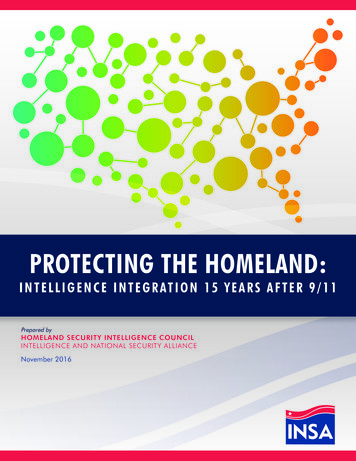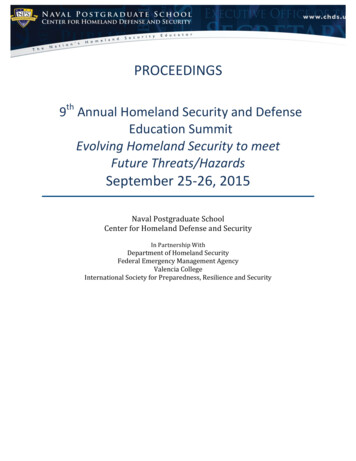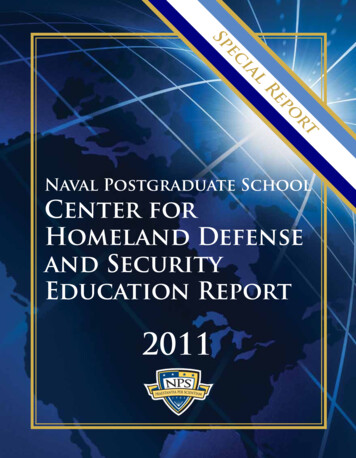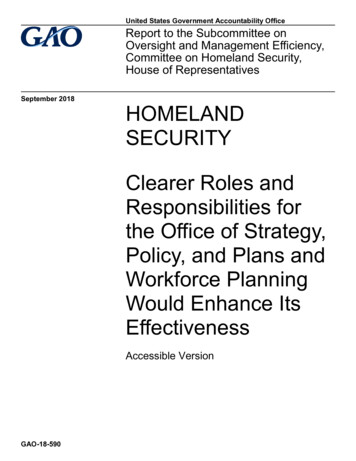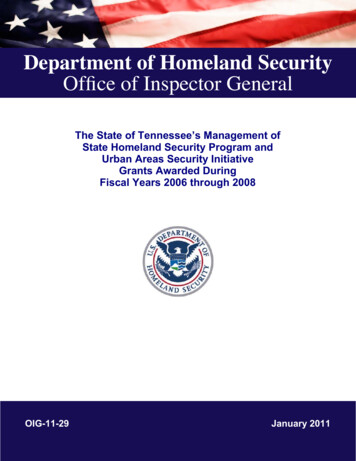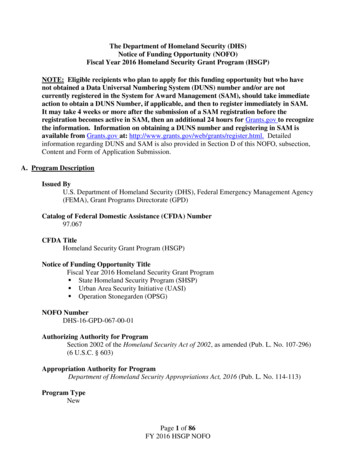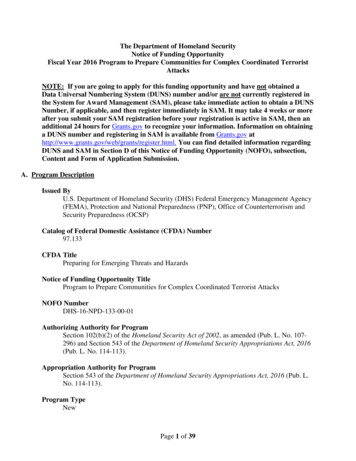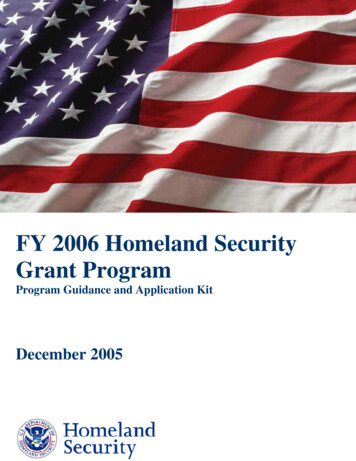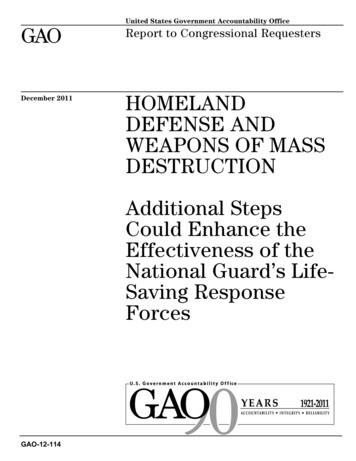
Transcription
ENHITTMT OF T HS W E' L LDEFEENDARDSTMTEERU NII CA MY DE PARJoint Publication 3-27AT E S O FAHomeland Defense10 April 2018
PREFACE1. ScopeThis publication provides joint doctrine for homeland defense.2. PurposeThis publication has been prepared under the direction of the Chairman of the JointChiefs of Staff (CJCS). It sets forth joint doctrine to govern the activities and performance ofthe Armed Forces of the United States in joint operations, and it provides considerations formilitary interaction with governmental and nongovernmental agencies, multinational forces,and other interorganizational partners. It provides military guidance for the exercise ofauthority by combatant commanders and other joint force commanders (JFCs), and prescribesjoint doctrine for operations and training. It provides military guidance for use by the ArmedForces in preparing and executing their plans and orders. It is not the intent of this publicationto restrict the authority of the JFC from organizing the force and executing the mission in amanner the JFC deems most appropriate to ensure unity of effort in the accomplishment ofobjectives.3. Applicationa. Joint doctrine established in this publication applies to the Joint Staff, commanders ofcombatant commands, subordinate unified commands, joint task forces, subordinatecomponents of these commands, the Services, and combat support agencies.b. The guidance in this publication is authoritative; as such, this doctrine will be followedexcept when, in the judgment of the commander, exceptional circumstances dictate otherwise.If conflicts arise between the contents of this publication and the contents of Servicepublications, this publication will take precedence unless the CJCS, normally in coordinationwith the other members of the Joint Chiefs of Staff, has provided more current and specificguidance. Commanders of forces operating as part of a multinational (alliance or coalition)military command should follow multinational doctrine and procedures ratified by the UnitedStates. For doctrine and procedures not ratified by the US, commanders should evaluate andfollow the multinational command’s doctrine and procedures, where applicable and consistentwith US law, regulations, and doctrine.For the Chairman of the Joint Chiefs of Staff:KEVIN D. SCOTTVice Admiral, USNDirector, Joint Force Developmenti
PrefaceIntentionally BlankiiJP 3-27
SUMMARY OF CHANGESREVISION OF JOINT PUBLICATION 3-27DATED 29 JULY 2013 Reorganizes Chapter I, “Fundamentals of Homeland Defense,” to describehomeland security (HS), defense support of civil authorities (DSCA), andhomeland defense (HD) as a unified approach; adds more information onDepartment of Homeland Security’s mission with respect to HS and thetransregional, multi-domain, and multifunctional nature of the transnationalthreat environment; adds information on unmanned aircraft systems, globalcampaign plans, and incident awareness and assessment; updates laws, policies,and terminology; and enhances the succinctness of the chapter. Adds information to Chapter II, “Command Relationships andInterorganizational Cooperation,” on unified action and properly defines UnitedStates Coast Guard’s (USCG’s) HD roles and the differences between maritimehomeland security (MHS) and maritime homeland defense (MHD) tasks, as wellas the required coordination between US Navy and USCG. Adds to Chapter II, “Command Relationships and InterorganizationalCooperation,” US Alaskan Command and removes Joint Task Force–Alaska;clarifies US Pacific Command’s role in HD and the MHD execute order; andupdates terminology and references to other joint publications. Covers Chapter III, “Planning and Operations for Homeland Defense,”operations in all domains for homeland defense; adds paragraph on MHSsupport to strategic sealift; aligns information operations as one of the seven jointfunctions; clarifies roles and responsibilities for homeland ballistic missiledefense; expands cyberspace operations and critical infrastructure protection;and moves joint reception, staging, onward movement, and integration verbiageto more pertinent location. Updates Appendix A, “Relationships Betweeen Homeland Security, HomelandDefense and Defense Support of civil Authorities,” to reflect changes made byNational Defense Authorization Act Fiscal Year 2017 and adds a more concisediagram depicting the relationship between HS, HD, and DSCA. Revises the explanation and mission of multiple interorganizational agencieswithin the United States Government in Appendix B, “FacilitatingInterorganizational Cooperation.” Updates Appendix C, “North American Aerospace Defense Command Missions,Organization, and Structure,” definitions and provides for a more succinctdocument. Updates references used throughout the document and removes extraneousdescriptors for Appendix D, “References.”iii
Summary of ChangesIntentionally BlankivJP 3-27
TABLE OF CONTENTSEXECUTIVE SUMMARY . viiCHAPTER IFUNDAMENTALS OF HOMELAND DEFENSE General . I-1Threats. I-4Homeland Defense Policy and Legal Considerations . I-5Active, Layered Defense . I-9The Homeland Defense Operational Framework . I-10CHAPTER IICOMMAND RELATIONSHIPS AND INTERORGANIZATIONALCOOPERATION General .II-1Unified Action .II-1Command and Control Relationships and Responsibilities .II-3Interagency Coordination.II-16Interorganizational Cooperation Considerations .II-21Multinational Forces .II-21CHAPTER IIIPLANNING AND OPERATIONS FOR HOMELAND DEFENSE General . III-1Strategic Guidance . III-1Operational Factors . III-1Intelligence Sharing for Homeland Defense . III-3Joint Fires . III-4Movement and Maneuver in the Conduct of Homeland Defense. III-5Protection . III-19Sustainment . III-26Other Activities and Efforts . III-31APPENDIXABCDEFRelationships Between Homeland Security, Homeland Defense,and Defense Support of Civil Authorities . A-1Facilitating Interorganizational Cooperation .B-1North American Aerospace Defense Command Missions,Organization, and Structure.C-1Joint Task Force Headquarters Enabling Capabilities Points of Contact . D-1References . E-1Administrative Instructions . F-1v
Table of ContentsGLOSSARYPart IPart IIAbbreviations, Acronyms, and Initialisms . GL-1Terms and Definitions . GL-8FIGUREI-1I-2II-1II-2III-1III-2A-1viHomeland Defense Transnational Threat Environment . I-5Guidance and Policy for the Intelligence Oversight Program. I-7United States Northern Command Homeland Defense CommandRelationships .II-7Maritime Homeland Defense and Maritime Homeland SecurityCommand Relationships .II-9Homeland Defense Land Operations Rapid Response Process . III-7Homeland Defense Land Operations Sustained Response Process . III-9Relationships Between Homeland Defense, Defense Supportof Civil Authorities, and Homeland Security Missions . A-2JP 3-27
EXECUTIVE SUMMARYCOMMANDER’S OVERVIEW Discusses fundamentals of homeland defense (HD), to include threats; policy andlegal considerations; active, layered defense; and the HD operational framework Describes command relationships and interorganizational cooperation in HD Outlines strategic guidance, operational factors, intelligence sharing, and jointfunctions considerations for planning and operations for homeland defenseFundamentals of Homeland DefenseThe United States Government (USG) employs allinstruments of national power to continuouslydetect, deter, prevent, and defeat threats to thehomeland. This national imperative translatesoperationally into homeland security (HS), defensesupport of civil authorities (DSCA), and homelanddefense (HD). The Department of Defense (DOD)is the lead federal agency (LFA) for defendingagainst traditional external threats or aggression(e.g., nation-state conventional forces or weaponsof mass destruction attack) and against externalasymmetric threats that are outside of the scope ofHS operations. The Department of HomelandSecurity (DHS) is the LFA for HS, and the UnitedStates Coast Guard (USCG) is the LFA formaritime homeland security (MHS). By law, DODis responsible for two missions in the homeland:DSCA and HD.HD is the protection of US sovereignty, territory,domestic population, and critical infrastructureagainst external threats and aggression or otherthreats, as directed by the President of the US.DOD executes HD by detecting, deterring,preventing, and defeating threats from actors ofconcern as far forward from the homeland aspossible. HD is executed across the active, layereddefense construct composed of the forwardregions, the approaches, and the homeland.Commander, United States Northern Command(CDRUSNORTHCOM), and Commander, Unitedvii
Executive SummaryStates Pacific Command (CDRUSPACOM), arethe supported commanders for HD in theirrespective areas of responsibility (AORs), with allother combatant commanders (CCDRs) assupporting commanders.ThreatsThe homeland is confronted by a variety of bothdisparate and interrelated threats that demandcoordinated procedures and synchronized effortsamong interagency partners responsible for lawenforcement and national defense, particularlythose who have overlapping roles, responsibilities,authorities, and capabilities.Homeland Defense (HD) Policyand Legal ConsiderationsWhen conducted domestically, certain intelligenceactivities, military information support operations,rules of engagement (ROE), and rules for the useof force (RUF) have specific limitations,applications, and legal considerations.Active, Layered DefenseDefending the homeland neither begins nor ends atUS borders, so DOD planning is guided by theconstruct of an active, layered defense—a globaldefense that aims to deter and defeat aggressionabroad and simultaneously protect the homeland.It is a defense-in-depth that relies on collection,analysis, and sharing of information andintelligence; strategic and regional deterrence;military presence in forward regions; and theability to rapidly generate and project warfightingcapabilities to defend the US, its allies, and itsinterests. This defense strategy integrates UScapabilities in the forward regions of the world, inthe geographic approaches to US territory, andwithin the US homeland.The HD Operational FrameworkThe HD operational framework includes the plansand actions taken to detect, deter, prevent, shape,and defeat threats and aggression against thehomeland. The purpose of HD is to protect againstincursions or attacks on sovereign US territory, thedomestic population, and critical infrastructure andkey resources as directed.viiiJP 3-27
Executive SummaryCommand Relationships and Interorganizational CooperationVirtually all the strategic threats to the homelandinUnitedStatesNorthernCommand(USNORTHCOM) and United States PacificCommand (USPACOM) AORs are based in theAORs of other geographic combatant commanders(GCCs). This requires command relationships fora collaborative, federated architecture for targetingby USNORTHCOM and USPACOM with theJoint Staff J-2 [Intelligence Directorate]; theintelligence directorates of the combatantcommands; the National Joint Operations andIntelligence Center; and other supporting CCDRs,especially those supporting GCCs in whose AORsthose strategic threats reside.Unified ActionUnified action is the synchronization, coordination,and/or integration of the activities of governmentaland nongovernmental entities with militaryoperations to achieve unity of effort. In HD, thisincludes interaction with joint, single-Service, andmultinational operations with the activities of otherinteragency partners, nongovernmental organizations(NGOs), international organizations, and the privatesector to achieve unity of effort.Command and ControlRelationships andResponsibilities:As stipulated in the Unified Command Plan (UCP),CDRUSNORTHCOM and CDRUSPACOM havespecified tasks for HD activities. They areresponsible for planning, organizing, andexecuting HD operations within their respectiveAORs. Other CCDRs support them and contributeto the protection of the US homeland eitherthrough actions within their own AORs (forwardregions and approaches) or through globalresponsibilities assigned in the UCP.Geographic CombatantCommander ResponsibilitiesFunctional CombatantCommander ResponsibilitiesCommander, United States Strategic Command(CDRUSSTRATCOM), is the lead CCDR forstrategic deterrence planning and executesstrategic deterrence operations, as directed.US Cyber Command can support HD COM, USPACOM, and DHS bycoordinating activities within the required AORix
Executive Summaryand assisting with expertise and capabilitiesdirected and made available.For operations conducted in the homeland,Commander, US Special Operations Command,serves as either a supported or supportingcommander for selected counterterrorism activitiesand serves as a supporting commander to the GCCswith geographic HD responsibilities within theirrespective AORs.ForHDoperations,Commander,USTransportation Command, provides, upon request,a director of mobility forces to advise on airmobility support operationsInteragency CoordinationHD operations are conducted in a complexoperational environment (OE) that containsthousands of different jurisdictions (federal, state,tribal, and local), many agencies and organizations,the private sector, and several allies and multinationalpartners. From a USG perspective, this necessitatescoordinated and integrated activities that have beenpreviously exercised/rehearsed to facilitate effectiveinteragency interoperability in addition to unity ofeffort. Coordination should be conducted through thedefense coordinating officer/defense coordinatingelement of the affected region. The inherentinterrelationships between HS, HD, and DSCA, andthe potential for transition between those missions,creates a dynamic and complex environment in whichinterorganizational coordination and resultinginteroperability could prove critical. From a DODperspective, understanding and executing themultiple command relationships and organizationalrelationships required for simultaneous execution ofHS, HD, and DSCA requires the utmost ininteragency coordination.Interorganizational CooperationConsiderationsHD mission response forces involve multipleorganizations. Operation NOBLE EAGLE, theNorth American Aerospace Defense Command(NORAD), USNORTHCOM, and USPACOMoperation aimed at defending the homeland,involves active duty personnel from the US AirForce, US Navy, the Canadian Forces, andNational Guard members federalized for thexJP 3-27
Executive Summarymission. These military forces coordinate withDepartment of Transportation (Federal AviationAdministration), DHS, the Department of Justice,and other USG departments and agencies.Multinational ForcesTo conduct the full range of HD operations,CCDRs should consider multinational andnonmilitary organizations. When a response forceresides within an alliance, the procedures andstructure of that alliance will normally determinethe operational-level leadership. When a responseforce is based in a coalition (or a lead-nationstructure in an alliance), the designated lead nationor other leadership mechanism will normally selectthe operational-level leadership.While thePresident and Secretary of Defense retaincommand authority over US forces, it is oftenprudent or advantageous to place appropriate USforces under the tactical control of a foreigncommander for reasons such as maximizingmilitary effectiveness and ensuring unity of effort.Planning and Operations for Homeland DefenseStrategic GuidanceGeneral strategy is provided in high-level policydocuments such as the National Security Strategy,Defense Strategy Review, and the NationalMilitary Strategy (NMS). Similarly, high-levelplanning guidance is provided in the UCP;Guidance for Employment of the Force andChairman of the Joint Chiefs of Staff Instruction3110.01, (U) Joint Strategic Capabilities Plan(JSCP). Planning architecture is provided inChairman of the Joint Chiefs of Staff Manual3130.03, Adaptive Planning and ExecutionFormats and Guidance.Operational Factors:Regardless of the size and scope of the particularoperations, inevitably they will involve multiplejurisdictions (such as cities, counties, regions, tribes,and states). Managing such relationships willrequire significant time and effort on the part offederal, state, local, and tribal authorities to ensureproper coordination.Civil and Military Relationshipsxi
Executive SummaryCommander’s CommunicationSynchronization and PublicAffairsJoint force commanders (JFCs) are required toinclude communication goals and objectives in thecommander’s intent and to have a communicationapproach that ensures unity of themes, objectives,and messages among key activities; consistency inintent or effect between command operations,actions, and information; and a risk assessment ofthe information that may reach unintendedaudiences, create unintended consequences, andrequire risk mitigation measures.Non-Department of DefenseFederal, State, Territorial, Local,and Tribal Planning FactorsInterorganizational cooperation must occurbetween elements of DOD and non-DOD federal,state, local, and tribal agencies, as well as otherparticipating USG departments and agencies forthe purpose of achieving HD objectives.Legal ConsiderationsMilitary operations inside the homeland canpresent unique and complex legal issues. Certainmilitary functions (e.g., intelligence operations,ROE, and RUF) have specific applications andlegal implications when conducted domestically.Coordination with the servicing office of the staffjudge advocate for legal advice should be as earlyin the operation planning process as possible.Intelligence Sharing for HDThe success of interorganizational cooperation inHD operations hinges upon timely and accurateinformation and intelligence. Information sharingenvironments should include as many essentialparticipants as possible, understanding that not allare capable of participating in a collaborativeenvironment. When possible, a collaborativeintelligence sharing environment should becapable of generating and moving intelligence,operational information, and orders where neededin the shortest possible time.Joint FiresJoint fires may be provided to assist air, land,maritime, or special operations forces inconducting HD activities within an OE framed bycomplex legal authorities and significantinteragency coordination.Although majoroperations against an enemy in the US remainhighly unlikely, various threats require capabilitiesand preparations to deter or defeat them. For thatxiiJP 3-27
Executive Summaryreason, the supported JFCs for HD haveplans/orders for HD operations that anticipate theuse of joint fires across the range of militaryoperations.Movement and Maneuver in theConduct of HD:Land Operations in the Conductof HDHD land defense actions may include movementand maneuver, fires (for lethal and nonlethaleffects), closing with and destroying an enemy,sustaining a joint force, and setting conditions fora return to peace. Specific HD land operations insupport of HD may include security operationsthrough force protection (FP) tasks or criticalinfrastructure protection (CIP). Defensive landoperations will make use of existing USGdepartments’ and agencies’ capabilities wherepossible (e.g., DHS).Maritime Operations in theConduct of HDMaritime operations in support of HD offer distinctchallenges due to the nature of execution in or nearthe homeland in conjunction with interagencypartners. DOD is the LFA for maritime HD and theUSCG is the LFA for MHS. Through the relevantCCDR, DOD provides an active, layered defense;supports USCG MHS operations with DODforces/capabilities; and defeats maritime threats tothe homeland beyond the scope of MHS. Wherecoordination under the maritime operational threatresponse plan is required, issues such asdesignation of lead and supporting agencies,desired national outcome, required capabilities,asset availability, and authority to act must bedetermined.Air Operations in HD OperationsNORAD is assigned the mission of aerospacecontrol (including air sovereignty and air defense)of the airspace of the US and Canada. NORADroutinely maintains forces on alert for homeland airdefense, cruise missile defense, and aerospacecontrol alert missions against long-rangeincursions.Space Operations in the Conductof HDTo deter or preempt attacks and to protect militaryspace assets, DOD conducts space operations insupport of HD. These activities may serve toprotect and defend the US’s ability to operate inand through space. CDRUSSTRATCOM is thesupported commander for protecting andxiii
Executive Summarydefending the right to operate in space and isresponsible for identifying, assessing, and securingDOD critical assets in space.Cyberspace Operations in theConduct of HDThe NMS for CO addresses three main roles: defenseof the nation, national incident response, and CIP.GCCs with geographic HD responsibilities shouldensure unified action at the theater level for CO. Thisincludes coordinating with multinational andinteragency partners as outlined in strategy, policy,and agreements.Information Operations in theConduct of HDInformation operations (IO) complements HDmovement and maneuver in all domains bygenerating effects in the information environmentthat give the JFC a decisive advantage in any and allof its dimensions: physical, informational, andcognitive. IO also plays a significant role in theJFC’s communication synchronization.Movement in Support of HDUS Transportation Command can quicklyassemble aircraft and flight crews for operationswhere expedited passenger movement is required.Surface transportation (commercial and organic)can be a viable option in those situations where thedistance between the home station and theoperational area is relatively short. Coordinationwith the National Guard Bureau is essential whenusing Air National Guard/Army National Guardassets for support of HD. In some instances, stateand federal forces may be in the same operationalarea. Coordination between state and federalforces should occur to achieve unity of effort.ProtectionThe protection function focuses on conserving thejoint force’s fighting potential in four primaryways: active defensive measures, passivedefensive measures, application of technologyand procedures to reduce the risk of friendly fire,and emergency management and response toreduce the loss of personnel and capabilities due toan all-hazards incident. It includes, but extendsbeyond, FP to encompass protection of USnoncombatants; the forces, systems, and civilinfrastructure of friendly nations; and other USGxivJP 3-27
Executive Summarydepartmentsandagencies,organizations, and NGOs.Sustainment:PersonnelinternationalThe core functional responsibilities of themanpower and personnel directorate of a joint staffare accomplished during any HD or other operationand are tailored to meet mission-specificrequirements.Personnel SupportThe authorities and responsibilities for personnelsupport to HD operations are largely the same asthose for any other DOD mission set. Someexceptions may apply to the USNORTHCOMAOR.LogisticsThe authorities and responsibilities for logisticsoperations in support of HD are largely the same asany other DOD mission set. Some notableexceptions, however, apply to HD operationswithin the US. More specifically, the exceptionsapply to the USNORTHCOM AOR.EngineeringMilitary engineering support may be requiredsimultaneously for HD and DSCA operations. Theprimary focus of the engineering effort will be tosustain and assist DOD forces employed in HD.The secondary effort will be DSCA, whenrequested and approved in accordance with DODguidance and applicable plans.Environmental ConsiderationsMilitary commanders employ environmentallyresponsible practices that minimize adverseimpacts to human health and the environment.Plans will be developed to reduce or eliminatenegative impacts on the environment and tominimizenegativeimpactstomissionaccomplishment caused by environmentaldegradation.CONCLUSIONThis publication provides joint doctrine for HD.xv
Executive SummaryIntentionally BlankxviJP 3-27
CHAPTER IFUNDAMENTALS OF HOMELAND DEFENSE“ the Secretary, with the approval of the President and after consultation withthe Chairman of the Joint Chiefs of Staff, shall provide, every two years ormore frequently as needed, to the Chairman written policy guidance for thepreparation and review of contingency plans, including plans for providingsupport to civil authorities in an incident of national significance or acatastrophic incident, for homeland defense, and for military support to civilauthorities. Such guidance shall include guidance on the employment offorces, including specific force levels and specific supporting resource levelsprojected to be available for the period of time for which such plans are to beeffective.”National Defense Authorization Act for Fiscal Year 20171. Generala. The Homeland. The US homeland is the physical region that includes thecontinental United States (CONUS), Alaska, Hawaii, US territories, and surroundingterritorial waters and airspace. The United States Government (USG) employs allinstruments of national power to continuously detect, deter, prevent, and defeat threats tothe homeland. This national imperative translates operationally into homeland security(HS), defense support of civil authorities (DSCA), and homeland defense (HD). TheDepartment of Defense (DOD) is the lead federal agency (LFA) for defending againsttraditional external threats or aggression (e.g., nation-state conventional forces or weaponsof mass destruction [WMD] attack) and against external asymmetric threats that are outsideof the scope of HS operations. The Department of Homeland Security (DHS) is the LFAfor HS, and the United States Coast Guard (USCG) is the LFA for maritime homelandsecurity (MHS). By law, DOD is responsible for two missions in the homeland: DSCAand HD.b. HS, DSCA, and HD operations and events may occur simultaneously and requireextensive coordination, integration, and synchronization. HS forms the foundation uponwhich the USG counters threats and hazards, consistent with Presidential Policy Directive(PPD)-8, National Preparedness. HS operations are constantly executed under legalauthorities that enforce the rule of law at all levels of government in all areas subject to USjurisdiction, including the homeland and its approaches. DSCA and HD build upon thefoundation of HS to counter the most sophisticated and/or nation-state threats that eitherexceed the scope of HS capabilities or require use of DOD authorities to defeat threats tothe homeland. Considerations regarding simultaneous HS, DSCA, and HD operations arecovered in more detail in Appendix A, “Relationships Between Homeland Security,Homeland Defense, and Defense Support of Civil Authorities.”(1) HS is an integrated concept developed as a result of the 11 September 2001attacks on the US. The 2010 Quadrennial Homeland Security Review describes HS as theintersection of evolving threats and hazards with traditional governmental and civicresponsibilities for civil defense, emergency response, law enforcement (LE), customs,I-1
Chapter Iborder control, and immigration. In combining these responsibilities under oneoverarching concept, HS breaks down longstanding stovepipes of activity that have beenand could still be exp
defense (HD). The Department of Defense (DOD) is the lead federal agency (LFA) for defending against traditional external threats or aggression (e.g., nation-state conventional forces or weapons of mass destruction attack) and against external asymmetric threats that are outside of the scope of HS operations. The Department of Homeland

